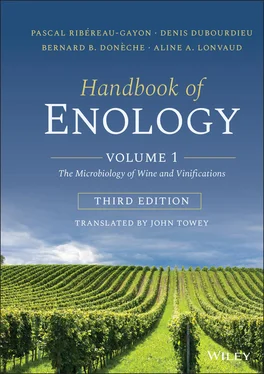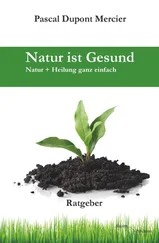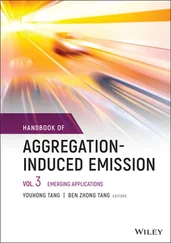1 Cover
2 Title Page
3 Copyright Page
4 Foreword
5 Preface to the Second Edition
6 Preface to the First Edition
7 Remarks Concerning the Expression of Certain Parameters of Must and Wine CompositionUnits Expression of Total Acidity and Volatile Acidity Evaluating the Sugar Concentration of Musts Measurements Using Visible and Ultraviolet Spectrometry
8 PART I: Microbiology of Wine CHAPTER 1: Yeasts 1.1 Introduction 1.2 The Cell Wall 1.3 The Plasma Membrane 1.4 The Cytoplasm and Its Organelles 1.5 The Nucleus 1.6 Reproduction and the Yeast Biological Cycle 1.7 The Killer Phenomenon 1.8 Classification of Yeast Species 1.9 Identification of Wine Yeast Strains 1.10 Ecology of Grape and Wine Yeasts References CHAPTER 2: Yeast Metabolism 2.1 Introduction 2.2 Sugar Degradation Pathways 2.3 Regulation of Sugar‐Utilizing Metabolic Pathways 2.4 Metabolism of Nitrogen Compounds References CHAPTER 3: Conditions of Yeast Development 3.1 Introduction 3.2 Monitoring and Controlling Fermentations 3.3 Yeast Growth Cycle and Fermentation Kinetics 3.4 Nutrition Requirements 3.5 Fermentation Activators 3.6 Inhibition of Fermentation 3.7 Physicochemical Factors Affecting Yeast Growth and Fermentation Kinetics 3.8 Stuck Fermentations References CHAPTER 4: Lactic Acid Bacteria 4.1 The Different Components of the Bacteria Cell 4.2 Taxonomy of Lactic Acid Bacteria 4.3 Identification of Lactic Acid Bacteria 4.4 The Oenococcus oeni Species References CHAPTER 5: Metabolism of Lactic Acid Bacteria 5.1 Generalities: A Review 5.2 Metabolism of Sugars: Lactic Acid Fermentation 5.3 Metabolism of the Principal Organic Acids of Wine 5.4 Other Transformations Likely to Occur in Winemaking 5.5 Effect of the Metabolism of Lactic Acid Bacteria on Wine Composition and Quality References CHAPTER 6: Lactic Acid Bacteria Development in Wine 6.1 Lactic Acid Bacteria Nutrition in Wine 6.2 Physicochemical Factors of Bacterial Growth 6.3 Evolution of Lactic Acid Bacteria Microflora: Influence on Wine Composition 6.4 Microbial Interactions During Winemaking 6.5 The Importance of Bacteriophages References CHAPTER 7: Acetic Acid Bacteria 7.1 Principal Characteristics and Cytology 7.2 Classification and Identification 7.3 Principal Physiological Characteristics 7.4 Metabolism of Acetic Acid Bacteria 7.5 Acetic Acid Bacteria Development in Grape Musts 7.6 Evolution of Acetic Acid Bacteria During Winemaking and Wine Aging and the Impact on Wine Quality References CHAPTER 8: The Use of Sulfur Dioxide in Must and Wine Treatment 8.1 Introduction 8.2 Physiological Effects 8.3 Chemistry of Sulfur Dioxide 8.4 Molecules Binding Sulfur Dioxide 8.5 Practical Consequences: The State of Sulfur Dioxide in Wines 8.6 Antimicrobial Properties of Sulfur Dioxide 8.7 The Role of Sulfur Dioxide in Winemaking 8.8 The Use of Sulfur Dioxide in the Winery References CHAPTER 9: Products and Methods Complementing the Effect of Sulfur Dioxide 9.1 Introduction 9.2 Sorbic Acid 9.3 Octanoic and Decanoic Acids (Saturated Short‐Chain Fatty Acids) 9.4 Dimethyl Dicarbonate (DMDC) 9.5 Lysozyme 9.6 Destruction of Yeasts by Heat (Pasteurization) 9.7 Ascorbic Acid 9.8 The Use of Inert Gases References
9 PART II: Vinification
10 Reflections on Global Taste and Typicity of Wines Conclusion Bibliography CHAPTER 10: The Grape and Its Maturation 10.1 Introduction 10.2 Description and Composition of the Mature Grape 10.3 Changes in the Grape During Maturation 10.4 Definition of Ripeness–Concept of Vintage 10.5 Impact of Various Other Factors on Maturation and Grape Composition at Ripeness 10.6 Botrytis cinerea References CHAPTER 11: Harvest and Pre‐fermentation Treatments: Harvest and Pre‐fermentation Treatments 11.1 Introduction 11.2 Improving Grape Quality by Overripening 11.3 Harvest Date and Operations 11.4 Acidity Adjustments of the Harvested Grapes 11.5 Increasing Sugar Concentrations 11.6 Enzymatic Transformations of the Grape After Harvest 11.7 Use of Commercial Enzymes in Winemaking References CHAPTER 12: Red Winemaking: Red Winemaking 12.1 Generalities 12.2 Mechanical Processing of the Harvested Grapes 12.3 Tank Filling 12.4 Controlling Alcoholic Fermentation 12.5 Maceration 12.6 Draining Off the Skins and Pressing 12.7 Malolactic Fermentation 12.8 Automated Red Winemaking Methods 12.9 Carbonic Maceration References CHAPTER 13: White Winemaking: White Winemaking 13.1 Distinctive Characteristics of White Winemaking 13.2 White Grape Quality and Picking Criteria 13.3 Juice Extraction 13.4 Protecting Juice from Oxidation 13.5 Clarification 13.6 Juice Treatments and the Advisability of Bentonite Treatments 13.7 Fermentation Operations 13.8 Making Dry White Wines in Barrels 13.9 Controlling Reduction Off‐Aromas During White Wine Aging References CHAPTER 14: Other Winemaking Methods: Other Winemaking Methods 14.1 Rosé Wines 14.2 Botrytized Sweet Wines (Sauternes and Tokaji) 14.3 Champagne and Sparkling Wines 14.4 Fortified Wines 14.5 Flor Wines References
11 Index
12 End User License Agreement
1 Chapter 1 TABLE 1.1 Classification of Grape and Wine Yeast Genera (Kurtzman et al ., 1994) TABLE 1.2 Physiological Characteristics of the Principal Grape and Wine Yeasts (B... TABLE 1.3 Evolution of the Nomenclature for the Saccharomyces Genus, 1952–2011 (L... TABLE 1.4 Physiological Races of S. cerevisiae Grouped Under a Single SpeciesS. c... TABLE 1.5 DNA/DNA Reassociation Percentages Between the Four SpeciesBelonging to ... TABLE 1.6 Characterization by PCR‐RFLP of the MET2 Gene of Various Commercial Str... TABLE 1.7 Characterization by PCR‐RFLP of the MET2 Gene of Various Species of Nat... TABLE 1.8 Rate of Occurrence of the Dominant Fzlb2‐89 Karyotype in Microvinificat...
2 Chapter 2 TABLE 2.1 Energy Balance of Oxidation of Glucose in Respiration TABLE 2.2 Isoforms of Acetaldehyde Dehydrogenase in S. cerevisiae (NavarroAvino e... TABLE 2.3 Effect of Initial Sugar Concentration of the Must on the Formation ... TABLE 2.4 The Principal Higher Alcohols Found in Wine and Their Amino Acid Pr...
3 Chapter 3 TABLE 3.1 Comparison of a Temperature‐Controlled (17–22°C) Fermentation and Isoth... TABLE 3.2 Available Nitrogen Content (NH4+ and Free Amino Acids Expressed in mill... TABLE 3.3 Maximum and Minimum Growth Factor Concentrations (μg/l) in Musts and Wi... TABLE 3.4 Sterol Concentrations in Yeasts During Alcoholic Fermentation of Grape ... TABLE 3.5 Effect of Air and Survival Factors on Grape Must Nitrogen Assimilation... TABLE 3.6 Effect of Ethanol Addition to Must on Fermentation (Limited Aerobic Con... TABLE 3.7 Stimulation of Wine Fermentation by the Addition of (NH4)2SO4 or Yeast ...TABLE 3.8 Stimulation of Red Wine Fermentation by the Addition of Yeast Hulls (Ma...TABLE 3.9 Average Fermentation and Respiratory Intensities (mm3 of O2 Consumed or...TABLE 3.10 Fermentation Onset Speed and Limits According to Temperature (Initial ...TABLE 3.11 Alcohol Formation (% vol.) According to Fermentation Temperature (...TABLE 3.12 Effect of Temperature Variations (Thermal Shocks) on Grape Must Fermen...TABLE 3.13 Evolution of the Fermentation of a Grape Must Containing a High Sugar ...TABLE 3.14 Effect of Oxygen Addition at Different Stages of Grape Must Fermentati...TABLE 3.15 Analysis of the Effect of Different Must Clarification Operations ...
4 Chapter 4TABLE 4.1 Principal Fatty Acids of Lactic Acid BacteriaTABLE 4.2 List of Lactic Acid Bacteria Species Isolated in Grape Must and WineTABLE 4.3 Determination of the Genus of Lactic Acid Bacteria Isolated in WineTABLE 4.4 Determination of Wine Lactic Acid Bacteria Species and Similar Species ...
5 Chapter 6TABLE 6.1 Influence of Culture Medium on the Evolution of Bacterial Populations (...TABLE 6.2 Influence of Different Types of Stress on the Protein Concentration of ...TABLE 6.3 Lactic Acid Bacteria Populations Counted by Epifluorescence (Cells/ml) ...TABLE 6.4 Population (CFU/ml) of the Different Lactic Acid Bacteria Species Durin...TABLE 6.5 Influence of the Addition of Fatty Acids (C10 and C12) on the Malolacti...TABLE 6.6 Influence of the Yeast Strain on Malolactic Fermentability of Wines (Lo...
Читать дальше












